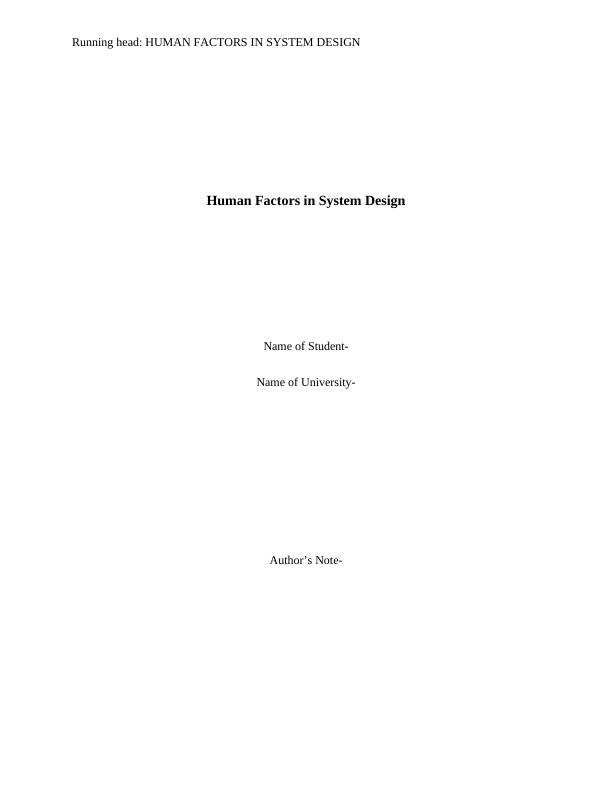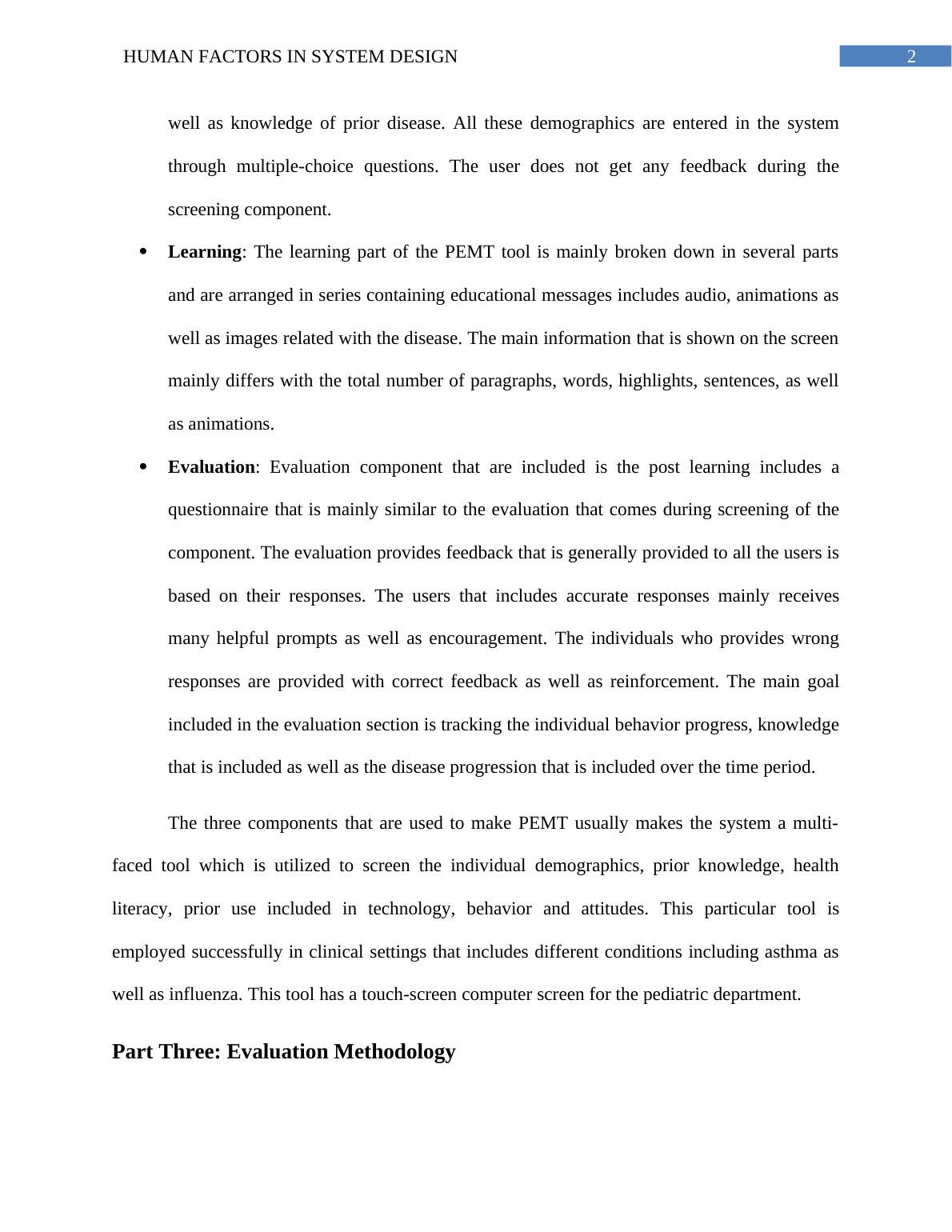Human Factors in System Design
Usability evaluation of an interactive system
11 Pages2232 Words487 Views
Added on 2022-11-29
About This Document
This article discusses the importance of human factors in system design and evaluates the usability of a specific interactive system. It covers topics such as interactive system components, use case, evaluation methodology, and findings.
Human Factors in System Design
Usability evaluation of an interactive system
Added on 2022-11-29
ShareRelated Documents
Running head: HUMAN FACTORS IN SYSTEM DESIGN
Human Factors in System Design
Name of Student-
Name of University-
Author’s Note-
Human Factors in System Design
Name of Student-
Name of University-
Author’s Note-

HUMAN FACTORS IN SYSTEM DESIGN1
Part One: Interactive System and the Users
The interactive system that is used for this evaluation is Patient Education and Motivation
Tool (PEMT). The PEMT is educational program that is computer based mainly on the
cognitive, humanistic, as well as behavioral learning theories. This particular tool is mainly used
to educate all the users and includes three main components that is screening, evaluation as well
as learning. The educational applications that are provided is a self-paced computer mediated
interactive environment that help to send the educational content to all the individuals or the
users related to condition of their health. This particular program is used for delivering the
information related to the health condition of the individuals that includes screening of breast
cancer, injury prevention, as well as asthma management.
The design of the PEMT includes three sets of learning theories that includes behavioral,
humanistic, as well as cognitive. There are main two ideas that are related to behavioral theory is
that learning is considered as some manifesto by behavior change and the instructional materials
that are based on technology should introduce increments. The cognitive learning are mainly
focused for providing proper education to all users along with the reinforcement. The humanistic
theory mainly highlights the willingness of the participants for learning as well as their ability
that is to be evaluated. The main outcome involved in learning mainly depends on the
presentation of all information and the way the learner processes the information.
Part Two: Use Case
The PEMT tool mainly includes three components:
Screening: This particular tool helps the user to input the information related to their
socio-demographic that includes their age, gender, the severity of disease, education, as
Part One: Interactive System and the Users
The interactive system that is used for this evaluation is Patient Education and Motivation
Tool (PEMT). The PEMT is educational program that is computer based mainly on the
cognitive, humanistic, as well as behavioral learning theories. This particular tool is mainly used
to educate all the users and includes three main components that is screening, evaluation as well
as learning. The educational applications that are provided is a self-paced computer mediated
interactive environment that help to send the educational content to all the individuals or the
users related to condition of their health. This particular program is used for delivering the
information related to the health condition of the individuals that includes screening of breast
cancer, injury prevention, as well as asthma management.
The design of the PEMT includes three sets of learning theories that includes behavioral,
humanistic, as well as cognitive. There are main two ideas that are related to behavioral theory is
that learning is considered as some manifesto by behavior change and the instructional materials
that are based on technology should introduce increments. The cognitive learning are mainly
focused for providing proper education to all users along with the reinforcement. The humanistic
theory mainly highlights the willingness of the participants for learning as well as their ability
that is to be evaluated. The main outcome involved in learning mainly depends on the
presentation of all information and the way the learner processes the information.
Part Two: Use Case
The PEMT tool mainly includes three components:
Screening: This particular tool helps the user to input the information related to their
socio-demographic that includes their age, gender, the severity of disease, education, as

HUMAN FACTORS IN SYSTEM DESIGN2
well as knowledge of prior disease. All these demographics are entered in the system
through multiple-choice questions. The user does not get any feedback during the
screening component.
Learning: The learning part of the PEMT tool is mainly broken down in several parts
and are arranged in series containing educational messages includes audio, animations as
well as images related with the disease. The main information that is shown on the screen
mainly differs with the total number of paragraphs, words, highlights, sentences, as well
as animations.
Evaluation: Evaluation component that are included is the post learning includes a
questionnaire that is mainly similar to the evaluation that comes during screening of the
component. The evaluation provides feedback that is generally provided to all the users is
based on their responses. The users that includes accurate responses mainly receives
many helpful prompts as well as encouragement. The individuals who provides wrong
responses are provided with correct feedback as well as reinforcement. The main goal
included in the evaluation section is tracking the individual behavior progress, knowledge
that is included as well as the disease progression that is included over the time period.
The three components that are used to make PEMT usually makes the system a multi-
faced tool which is utilized to screen the individual demographics, prior knowledge, health
literacy, prior use included in technology, behavior and attitudes. This particular tool is
employed successfully in clinical settings that includes different conditions including asthma as
well as influenza. This tool has a touch-screen computer screen for the pediatric department.
Part Three: Evaluation Methodology
well as knowledge of prior disease. All these demographics are entered in the system
through multiple-choice questions. The user does not get any feedback during the
screening component.
Learning: The learning part of the PEMT tool is mainly broken down in several parts
and are arranged in series containing educational messages includes audio, animations as
well as images related with the disease. The main information that is shown on the screen
mainly differs with the total number of paragraphs, words, highlights, sentences, as well
as animations.
Evaluation: Evaluation component that are included is the post learning includes a
questionnaire that is mainly similar to the evaluation that comes during screening of the
component. The evaluation provides feedback that is generally provided to all the users is
based on their responses. The users that includes accurate responses mainly receives
many helpful prompts as well as encouragement. The individuals who provides wrong
responses are provided with correct feedback as well as reinforcement. The main goal
included in the evaluation section is tracking the individual behavior progress, knowledge
that is included as well as the disease progression that is included over the time period.
The three components that are used to make PEMT usually makes the system a multi-
faced tool which is utilized to screen the individual demographics, prior knowledge, health
literacy, prior use included in technology, behavior and attitudes. This particular tool is
employed successfully in clinical settings that includes different conditions including asthma as
well as influenza. This tool has a touch-screen computer screen for the pediatric department.
Part Three: Evaluation Methodology

HUMAN FACTORS IN SYSTEM DESIGN3
Heuristic evaluation that is included in evaluation methodology is considered as a better
evaluation technology is there are wide number of people that are used for conducting the
evaluation dependent on each other. The heuristic evaluation that is used for this evaluation is
stated by Jacob Nielsen and this is mostly used for usability for the user interface design. The
most severity that is included in evaluating usability includes frequency, the impact of the
problem as well as the persistence of the problem. The heuristic evaluation that was carried out
included reviewing of the user interface of PEMT as well as generate a list containing heuristic
violations. One heuristic expert who was included in evaluation was nurse who had 15 year
experience of clinic as well as was an HCI experienced user and has undergone many studies of
heuristic evaluation. The second expert who was chosen for the heuristic evaluation was a
professional expert having 12 years of experience for conducting the usability design as well as
includes heuristic evaluation. The last expert chosen for this heuristic evaluation was a HCI PhD
student who has experience of heuristic evaluation in many studies. All the experts who were
involved in this evaluation firstly viewed includes user interface of the PEMT tool that is
considered independently and individually they have generated including list containing heuristic
violations that have been viewed.
For this heuristic evaluation, the experts involved gave ratings independently on their
severity using a scale. While rating the problems, all the persistent issues that were included in
the interface of the PEMT tool were rated by the experts. The major and severe problems that
were noticed by the experts were given the highest rating. The severity of all the violation rated
were calculated from their ratings. Three independents lists of rating were them combined for
continuing the heuristic evaluation and conclude a single list from all three heuristic evaluation
of three experts. The severity ratings, and their suggestions were taken in to consideration for
Heuristic evaluation that is included in evaluation methodology is considered as a better
evaluation technology is there are wide number of people that are used for conducting the
evaluation dependent on each other. The heuristic evaluation that is used for this evaluation is
stated by Jacob Nielsen and this is mostly used for usability for the user interface design. The
most severity that is included in evaluating usability includes frequency, the impact of the
problem as well as the persistence of the problem. The heuristic evaluation that was carried out
included reviewing of the user interface of PEMT as well as generate a list containing heuristic
violations. One heuristic expert who was included in evaluation was nurse who had 15 year
experience of clinic as well as was an HCI experienced user and has undergone many studies of
heuristic evaluation. The second expert who was chosen for the heuristic evaluation was a
professional expert having 12 years of experience for conducting the usability design as well as
includes heuristic evaluation. The last expert chosen for this heuristic evaluation was a HCI PhD
student who has experience of heuristic evaluation in many studies. All the experts who were
involved in this evaluation firstly viewed includes user interface of the PEMT tool that is
considered independently and individually they have generated including list containing heuristic
violations that have been viewed.
For this heuristic evaluation, the experts involved gave ratings independently on their
severity using a scale. While rating the problems, all the persistent issues that were included in
the interface of the PEMT tool were rated by the experts. The major and severe problems that
were noticed by the experts were given the highest rating. The severity of all the violation rated
were calculated from their ratings. Three independents lists of rating were them combined for
continuing the heuristic evaluation and conclude a single list from all three heuristic evaluation
of three experts. The severity ratings, and their suggestions were taken in to consideration for

End of preview
Want to access all the pages? Upload your documents or become a member.
Related Documents
Social Cognitive Theory in Health Promotionlg...
|6
|1515
|94
Learning Environment Types | Assignmentlg...
|5
|955
|34
Development of Learning Theories From Behaviourism to Humanism - Essaylg...
|9
|2465
|745
Research Paper Human Computer Interactionlg...
|5
|790
|118
Application Of Learning Theorieslg...
|10
|2642
|27
Learning Theories and Dementia Carelg...
|9
|1972
|331
